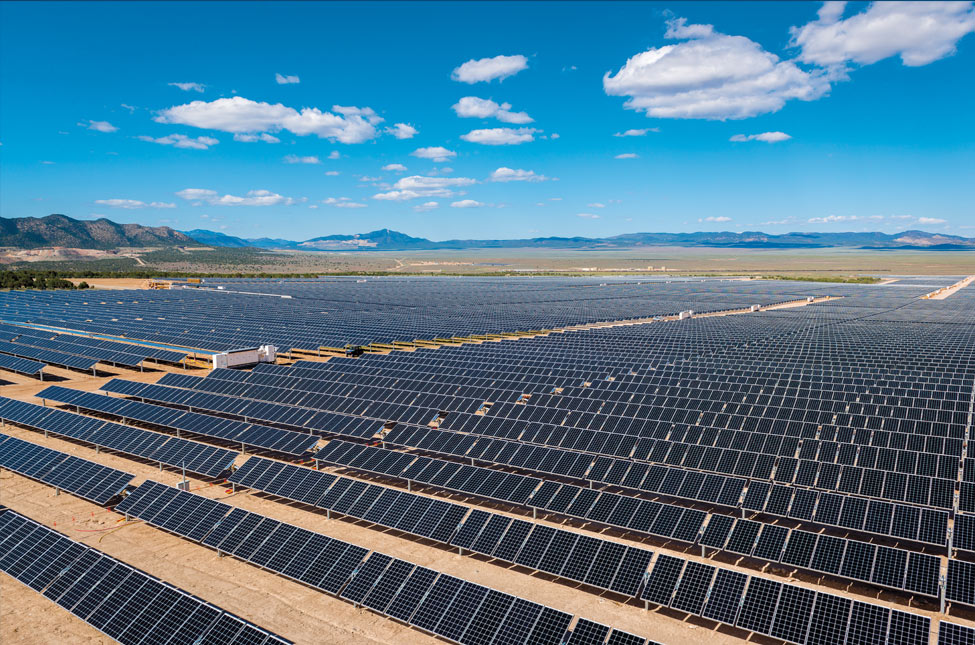Air
Renewable energy drives economic prosperity and reduces our environmental footprint, says Goldman Sachs’ Michael Conti ’06.
As the altimeter approaches 13,500 feet, the skydivers are deep in concentration.
Then it’s time. The group jumps, hurtling back to Earth, fortified by a unique blend of skill, experience, science and some level of faith as they grab hold and ride gravity’s unforgiving wave until, with a perfectly timed tug of the rip cord, their parachutes open wide.
Michael Conti ’06 has jumped out of more than 1,200 planes over the past decade. The clear blue skies are his favorite playground.
As an equally passionate environmentalist and leader in the clean energy industry, Conti has applied his vast knowledge of renewable power to not only pursue a career path aimed at disrupting the energy space, but to also help make skydiving as green as possible.
In 2018 Conti was hired as a vice president in Goldman Sachs’ Renewable Power Group, an independent entity within the firm that invests primarily in distributed generation solar power projects—a piece of Goldman’s ambitious $750 billion commitment to sustainable finance and technologies that don’t produce the carbon emissions and pollution directly tied to warming temperatures and extreme weather events. Prior to joining Goldman, Conti created an offset program for Transformation Carbon to help the skydiving community offset its carbon footprint while also assisting underserved populations around the world.
The initiative gives skydivers the opportunity to simultaneously make their activities carbon neutral and support projects in developing countries like Zambia, where residents are provided with efficient, environmentally friendly cookstoves. Programs like this produce a positive ripple effect with a social impact that extends beyond eco-responsibility in ways that seem unrelated. For example, these stoves dramatically reduce the time people need to spend gathering wood for cooking fuel, which leads to more time for kids to go to school.
CONTI FIRST LEARNED about carbon offset initiatives while he was at Conn. The College was an early adopter of such policies at a time when most institutions weren’t even really aware of them.
A few short years ago, the notion that a prominent financial services organization would demonstrate such an aggressive commitment to renewable energy development might have struck some people unfamiliar with the favorable economics of the sector as surprising, but Goldman actually began exploring sustainable finance relatively early. And in recent years, the financial viability of solar, in particular, has continued to demonstrate an undeniable momentum.
“There have certainly been some major advancements over the past 10 to 15 years in terms of renewable energy technology and public policy,” Conti says. “What’s important to recognize is that the unsubsidized economics of both solar and wind power generation have been gradually, but predictably improving to the point where they have either achieved or are very quickly approaching grid parity in major power markets all over the globe, meaning that the technology and the business around it stands on its own two feet without government subsidies, which is impressive, considering every other energy sector in the U.S. receives various forms of permanent subsidization.”
That transformation accelerated dramatically over the past decade, and the data explains why smart investors are banking on the future of clean energy with confidence.
In the past 10 years, three major sources of alternative energy have become far more affordable as a result of technological advances, improved manufacturing and installation efficiencies, public policies that incentivize development, and greater access to new renewable resource environments like offshore wind farms.
Since 2010, the costs of solar power and large batteries have dropped by 85%, while wind power has become 50% cheaper. Conti says he believes the trend will only continue.
“Once you see the data, it becomes pretty obvious why large institutional and infrastructure investors, as well as entrenched oil companies and other industries and organizations, would want to invest in this space, and why so many major corporations and universities are buying clean power,” Conti says, pointing out that nearly 20 GW of clean energy contracts were negotiated last year by more than 100 corporations in 23 countries across the globe.
AT CONN, Conti majored in economics and minored in government, but his specific career ambitions in clean energy were born out of an environmental science course he took his second year that sparked a new passion for an industry he believed would affect positive change and showed clear potential for profit and economic growth—characteristics that can sometimes seem mutually exclusive in some industries.
“I was attracted to the prospect of making a good living while also doing good for the world,” Conti says. “While I was at Conn it became apparent to me that these technologies and the industry that would form around them would be one of the larger drivers of job growth, one of the larger drivers of investment and infrastructure development for the foreseeable future, and I wanted to be a part of that. I even spent my final two years at the College writing a thesis about the clean energy market that I saw developing.”
After graduation, Conti pursued jobs in the renewables field, despite the industry being still in its formative stages, and landed a position as a researcher in New York with New Energy Finance (NEF), which offers news, market forecasts and investment analysis involving green energy. Conti and his colleagues grew the tiny operation into the premier source for industry information, and NEF was purchased by Bloomberg in 2010. It is now referred to as BNEF.
“What was unusual about that job, and why I feel so lucky, is that it was a company that gave young, motivated people an incredible platform to become experts on emerging technologies, investment trends and policy, which has served me well,” he says.
After four years with New Energy Finance, Conti began to feel a growing sense that he wanted to be on the business side of the industry, right in the middle of the dealmaking, not simply writing and talking about it. But, recognizing that he needed to expand his skill set and experience before embarking on that new path, he decided to attend the International Energy Financing Policy Program at Columbia University’s School of International and Public Affairs to prepare him for the project development and investment side of the renewables landscape.
“I needed to become more well-rounded as an energy professional by expanding my personal knowledge base beyond renewable energy to include everything about energy markets, including oil and gas markets, electricity, and transportation,” says Conti. “I knew that if I was ever going to be successful in helping to advance the commercialization of clean energy technology, I first needed to be an expert on much more than just the segment of the industry that I cared about the most,” he adds.
Reluctant to pause the professional momentum he’d built up over the previous four years while he returned to school, he was able to venture into the policy realm, co-authoring Congressional testimonies on domestic energy policy, and he regularly drafted industry white papers and created presentations with the American Council on Renewable Energy and the Partnership for Renewable Energy Finance.
And while this experience exposed Conti to a wide variety of sectors within the clean energy business, from solar, wind and batteries to more niche areas like waste energy and bioenergy, by 2013, he was increasingly focused on solar.

